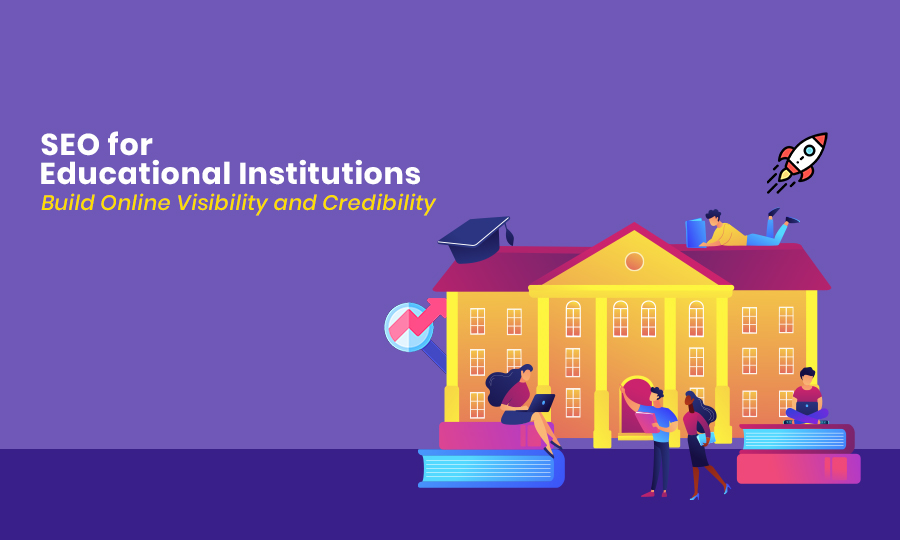Search engine optimisation is a need for educational institutions. With time, students ‘ approach towards finding a credible educational institution has changed. Now, students find institutions online for further education. To attract prospective students, your educational institution must be at the top of the search results. It has been reported by RNL that 58% of the students use college websites to gain information. These factors are enough to prove the importance of SEO for educational institutions.
What is SEO for an Educational Institution
SEO for educational institutions is when the institution optimises its website to rank higher in the search engine results pages. This is done to attract prospective students searching for an institute that offers the same courses, degrees the students are looking for.
SEO students who saw your ads on other websites visit your site and get to know more about your institution. By optimising your site, you can witness an increase in the number of organic search traffic, and most importantly, it increases the chances of students discovering your site over your competitors’ sites, boosting the number of applicants.
How Educational Institutions Benefit from SEO
SEO for educational institutions is proven to be effective and beneficial.
- Generate Organic Traffic – Search engine optimisation helps educational institutions to generate organic traffic. It can do so by optimising the website to rank higher in the search engines for searches related to relevant queries. When a prospective student searches for keywords that are integrated into your website’s meta title, meta tags, and descriptions, it automatically increases the visibility of your site. It attracts qualified visitors to your site without any paid advertisement.
- Enhanced user experience – Search engine optimisation for educational institutions also works in favour of enhancing user experience. A well-optimised site means it will be easy to navigate, mobile-friendly, and fast. By optimising the search ranking, it ensures that when someone visits your site, they experience a website that provides them with the exact information they are looking for easily.
- Builds trust – SEO positions the educational institutions as credible authorities. It provides easy access to information and provides high-quality user user-friendly content. When your website ranks higher on the search engine pages, it ultimately establishes your site as a trusted source of information.
- Local reach – Local SEO is an effective SEO strategy for educational institutions. It significantly increases visibility, builds trust, and drives enrolments from nearby communities. It helps you to be visible prominently to geographical location-based search queries. It drives more website traffic by increasing the visibility of your institution.
- Gives Competitive Advantage – With increased visibility, education institutes ultimately gain a competitive advantage. It establishes authority and attracts prospective students more effectively in comparison to your competitors.
Best Practices for Education Institution SEO
The best search engine optimisation practices for educational institutions are:
- Keyword Research for Education
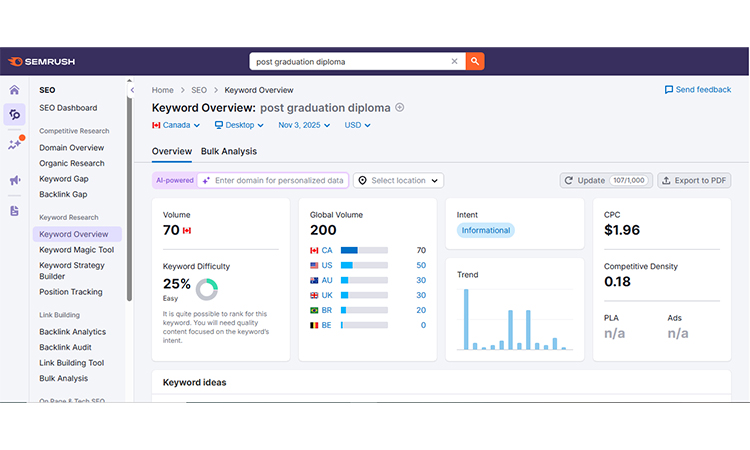
Before you begin to perform keyword optimisation for higher education, you must understand the intent of your target user and their search habit to attract them to your site. Follow these steps for successful keyword research.
The first step in your keyword strategy is to be clear about the audience you are trying to reach and what you are trying to achieve overall. You have created distinct user personas based on the category of your audience.
You need to begin with a long tail keyword that will later help find more keywords. Use programme names like ” PG diploma in human resource management”, or “organisational behaviour courses near Houston”, and so on.
Long tail keywords have a greater conversion rate. See by targeting long tail keywords you are lowering the competition, increasing the conversion rate and and aligning it with the users’ search intent.
Use tools to find thousands of keyword suggestions, like:
- Google keyword planner – It is a free tool that is a part of Google Ads. It provides keywords along with their search volume and keyword ranking.
- Ahrefs – It is a proper SEO tool that can be used to find the right keywords. It also provides you with metrics like monthly search volume and keyword difficulty. This makes it easy for you to find potential keywords, whether you are doing a paid or organic campaign.
- Semrush – It is another SEO tool that is very helpful in keyword research to find relevant keywords by utilising tools like Magic Key tools to generate ideas, and the keyword overview tool for analysing specific keywords.
- On-page Optimization
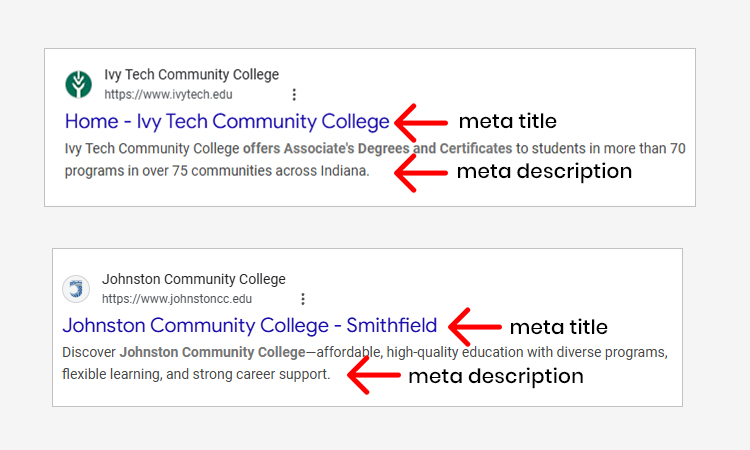
On-page SEO for education institutes involves optimising title tags, meta descriptions with keywords, and creating high-quality quality informative content. Let’s discuss in detail how we can perform successful on-page optimisations for your educational institutions.
- On-page optimisation begins with integrating the keywords strategically into the meta title, meta description. Use headers to give a logical structure to your content.
- You can also incorporate structured data to provide search engines with explicit information about your courses, events, and reviews. This allows you to display the content in a very visually rich and engaging way. This can help your institute attract more potential leads to your site.
- You can perform internal linking of departments, courses, and blogs by implementing strategically structured content. It is important as this increases user satisfaction. See, internal linking makes it easy for the user to navigate through your website pages with ease. It increases website authority and makes your website page search engine crawl-friendly.
- Content marketing for Education
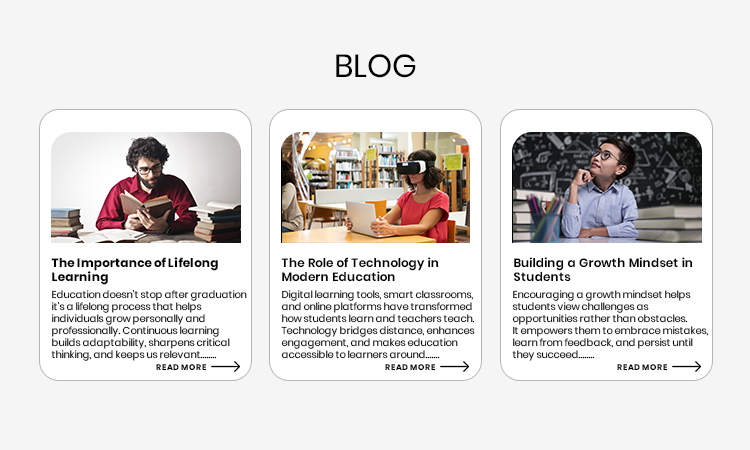
Content marketing for an educational institute involves:
- Creating blogs around student life, admission tips, and career guidance is a part of educational institution content marketing. It involves content such as blog content posts and articles, infographic content, college tour videos, webinars, social media posts, etc. It is beneficial for your institute cause when people search for schools, they search for relevant topics. Organic content drives organic traffic to your site, and it positions your institution as the thought leader in the field.
- Video content is a part of video SEO strategies. Contents like success stories and alumni interviews give the interested candidates a basic visual tour of your institute.
- Success stories of your former students leave a positive psychological effect on the aspiring candidates and motivate them. Witnessing the success stories of former students gives them a sense of belief that they can also achieve something big in their lives.
- Alumni interviews are important as they play the role of real real-life example of how your institution has helped them to shape their future and achieve where they are right now.
- FAQs are a valuable resource to answer student inquiries that make their browsing journey more productive. Student testimonials are the most effective tool for trust building. See, when one student sees another student’s success stories, it ultimately builds credibility and trust by providing real proof from real people.
- Link Building for Educational Websites

Link building is a key part of SEO for academic services as it helps your institute to build authority and credibility among its competitors.
By collaborating with educational bloggers, you can establish yourself as an expert in this industry. It also allows you to expand your professional network and provides you with a platform to share teaching strategies. Collaborating with the media is a way to advertise your institute and reach out to a vast audience. It enhances credibility through trusted sources and boosts engagement.
Collaborating with alumni is also beneficial because they provide real-life experiences they have had at your institution, and how your educational institution helped them become something in their lives.
Publishing research papers increases visibility for both the institute and the researcher. It fosters academic growth through knowledge sharing, career advancements, and collaboration.
Guest blogs provide real-life insights on how your institute functions, the position it holds in the educational field, and its authenticity and credibility.
Earning backlinks is also a pivotal part of content marketing. These backlinks can help you push your search engine ranking because backlinks are perceived as a vote of confidence. So when you earn links from authoritative sites, it signals the search engines that this institution is a reliable source of information.
- Technical SEO for Educational Institution
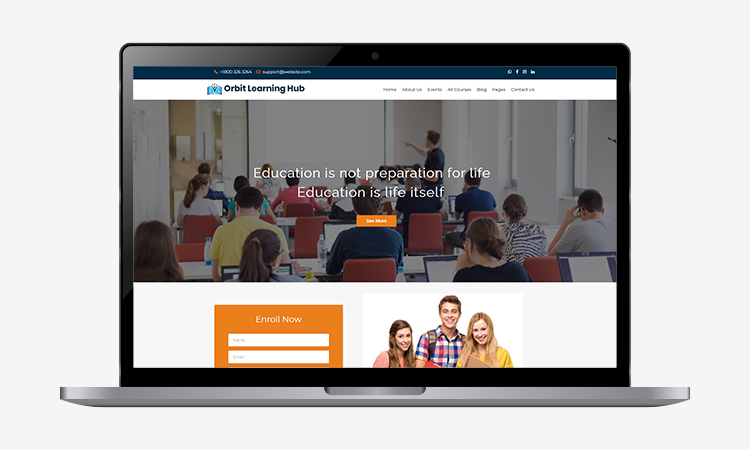
Technical SEO primarily focuses on optimising the website and network. It helps search engines to find, crawl, and index the pages of your website. Its key areas include:
- Website structure – Maintaining a well-structured site is important for SEO for education websites. A site structured hierarchically eases navigation for users and internal linking for the search engines. The key benefits of website structure are:
- A clear hierarchical structure is important as this eases the process of crawling and indexing for search engine bots and boosts optimisation efforts.
- A well-structured webpage is more engaging, and it also reduces bounce rate by making navigation easier.
- A well-structured and navigation-friendly website is favoured by the search engines and has better chances to appear at the top of the search results, which leads to more organic traffic.
To build a proper website structure, you need to keep some factors in mind, such as
- The site must be well organised and have with logical structure
- Maintain a navigation menu to help the user find what they are looking for
- By using a concise and descriptive URL, you make it easy for the user and search engine
- Create a strong internal link structure for easy navigation to important content
Using structured data for courses, reviews, and FAQs – Structured data or schema markup is important for your website. See, when someone clicks on an education institute’s website, they are more likely to visit certain pages like courses, academic program pages, reviews, and the FAQ section. So when you use schema markup for these webpages, it helps search algorithms to understand and index these pages precisely.
Not only for search engines, but even when someone enters your website, navigation gets easy for them because of structured data.
The benefits of using structured data for courses, reviews, and FAQs are:
- It helps search engines understand the context of your website content.
- It allows the courses, reviews, and FAQs to appear in rich results.
- As rich results are more visually appealing prominent it encourages more clicks on the website link.
- Structured data helps your website appear in search trends.
- It lets you stand out from those who are not using structured data markup.
- Mobile Optimisation– Mobile optimisation of your website is very important as it establishes you as a valuable source of information. It is a basic necessity for your website for obvious reasons, as most of the searches are done on mobile devices. To design a mobile-friendly site, keep these points in mind.
- Use mobile mobile-responsive template so that the website adapts to all screen sizes.
- Use a simple, easy-to-understand menu for mobile users.
- Stack columns vertically instead of placing them side by side, so that it adjusts to all screen sizes.
- Display the important content first and hide the less significant one.
- Avoid long paragraphs; use short and catchy phrases.
- Use readable and clear font sizes.
- Reduce the size of images by compressing and resizing them, as this increases the site speed.
Mobile optimisation of your website has several benefits, like:
- The content gets easy to find and read as navigation between pages gets easier.
- It enhances the accessibility of your content means readers can get to your content from all devices.
- Well-optimised sites load quickly, decreasing the bounce rate.
- It increases the search visibility because Google prefers mobile-friendly sites.
- It reaches out to a wider range of audiences.
- A mobile-optimised site indicates that the institution is professional and user-centric.
- Page Speed– Page speed is the time it takes your web pages to load on screen. It plays an important role because it has a direct impact on the user experience, search engine ranking, and conversion rate. If the page speed is low, then it will lead to higher bounce rates and user abandonment. A fast-loading page has a higher conversion rate. Here are a few tips on how you can optimise:
- Use smaller-sized images as larger-sized images are more likely to slow down page loading speed.
- Use the images in JPEG format.
- Use webm format for videos.
- Compress multiple CSS and JavaScript files into fewer files to reduce the requests.
- Remove unnecessary characters and whitespaces from code.
- Use a content delivery network to increase the reach of your content to different geographical locations via different servers.
- Upgrade your hosting plan, as this can also impact website performance.
The benefits of a fast page speed are:
- It improves the user experience by providing them with information quickly.
- It increases your search engine ranking because search engines like Google prefer fast-loading sites.
- A website that provides quick answers to users’ queries has a lower bounce rate.
- Smooth website experience leads to a higher conversion rate.
- Local SEO Optimisation
It is a digital marketing strategy to optimise your university’s online visibility in location-based searches. To optimise your university for local SEO, you need to follow these steps:
- Optimisation of Google Business Profile – Google Business Profile functions like a storefront on Google Maps and Google search results. There are a few steps you have to follow for Google Business Profile optimisation.
- Fill out every section of your profile, like business category, description, and any offered services.
- Ensure that the mentioned business hours are accurate
- Upload high-quality images and videos of your classrooms, faculty
NAP – NAP or name, address, and phone number is also important. Always maintain its accuracy across your business profile, university website, and local directories. Maintaining NAP consistency is important because:
- It signals search engines that your business is reliable and trustworthy.
- Consistency improves your local search rankings.
- It provides an improved user experience.
- It is a fundamental part of local citation.
- Local directories and maps – Getting your school’s site enlisted in local directories is a crucial part of local SEO. It helps search engines understand your university’s physical location and increases visibility in local search results. Its role in local SEO is:
- Local directory listing impacts your visibility on Google Maps.
- Getting enlisted on reputable directories builds trust and authority.
- Getting enlisted on directories gives the user direct access to your business profile.
- You can also focus on local link building, which means acquiring backlinks from other websites. Businesses that are relevant to your geographical location.
- Encouraging Students and parents to leave a review – Encouraging students and parents to leave a review leads to your university’s prominence, strong online presence, and makes your institution relevant to the local potential customer. Its key benefits are:
- If your institute has a higher number of positive reviews signals to the search engines about the trustworthiness and popularity of your institute.
- A large number of positive reviews builds a sense of trust among parents who are browsing for enrolment options.
- Reviews by genuine people function as social proof. And institutes with a higher number of positive reviews stand out from their competitors.
- A higher number of positive reviews means a higher click-through rate.
Measuring SEO Success
Measuring SEO success is important for a better understanding of the effectiveness of your strategies. Return on investment demonstration, and making adjustments based on data. It provides you an insight into what is working, if there are any possible threats, campaign optimisation, and whether the investments are productive or not. SEO success measurement is beneficial for your educational institute for many reasons, like:
- You can clearly evaluate the well-performing SEO strategies and those that need improvement. It is not possible without measuring SEO.
- It allows you to adjust your SEO strategies. You can review what worked and what did not, and make changes to your strategies accordingly.
- Metrics like scroll depths, bounce rate, and hovering time give you an understanding of whether people are finding what they are looking for on your page.
Metric tracking – You can track metrics like organic traffic, ranking form submission, and conversion for the performance review of your SEO strategies.
Ranking form submission – This metric provides you insight into user preferences, priorities, and drives data-based decision-making.
Conversion – Tracking conversion is important for measuring marketing effectiveness, optimising ad spend, and improving campaigns for a better return on investment.
You can also use certain key metric measurement tools for accurate measurements, like:
- Google Analytics – Google Analytics is an effective tool for measuring SEO success. It connects business outcomes like revenue and conversion with data on your campus page traffic, which indicates the impact of SEO efforts. The factors that make it important for SEO are:
- It connects the traffic source with conversion and revenue to prove the return on investment of your SEO efforts.
- After implementing new SEO strategies, you can track the changes in organic traffic and check what’s working and what’s not working.
- It lets you identify that the webpage and content are driving more traffic. This way, you can produce more content that is similar to that.
- It shows you the gaps on your website, and it does it by analysing user behaviour and search intent. It gives you an understanding of what exactly your audience is looking for
- You can utilise Google Analytics to form hypotheses, ask questions, and then use the data to create actionable insights and adjustments to your data.
- You can track user activity on your website from the exact moment they arrive at your website.
- Google Search Console – Google Search Console is a critical tool from Google that is used for tracking performance data. It offers valuable insights straight from the source, helping you track site health, detect issues, and discover growth opportunities. With this tool, you can analyse search visibility, identify technical problems, measure performance, submit sitemaps, and request indexing.
It also shows how your site appears in search results, which keywords drive clicks, how often users interact with your pages, and whether search bots can easily crawl and index your site.
Its key importance is:
- Google Search Console’s performance report allows you to measure search traffic and user interaction, which includes the number of clicks, impressions, average click-through rate, and average ranking position of specific queries
- It is very important that your content can be easily found and accessed by Google. The index coverage and crawl stats reports highlight specific errors that prevent pages from being indexed and crawled efficiently.
- Its URL inspection tools let you test individual URLs so that you can debug the issues and request indexing in real time. It is pivotal for the mobile-first indexing approach.
- It sends you a report on the validity and performance of the structured data that you have used on your website. When you implement the structured data correctly, it improves the search appearance and leads to a higher click-through rate.
- Its link reports provide you with information about both the internal and external links on your site. It analyses the top-linked pages, referring domains to help in figuring out the quality of the link.
- Monitor Admission Inquiries from Organic Sources
Monitoring admission inquiries from organic sources means tracking and analysing the sources the students have used to arrive at your website. These sources can be unpaid natural channels rather than paid advertising or marketing campaigns. The key examples of these sources are:
- Search Engines – It is most commonly used by students looking for an institute for higher education.
- Direct Website Visit – It is when the student types in the university’s URL in the search box. It mostly happens in cases where the user is already aware of the institution.
- Content Marketing – When a student inquires after reading a blog or piece of content online that is published by the institution, that aligns with the student’s query
- Social Media – When a student discovers your institute through a shared post, link, or unpaid mention on social media platforms like Facebook, Instagram, TikTok, and so on, and clicks on the provided website link
- Referrals – When a former student of your institute recommends a new student, encourage the aspiring student to inquire.
- Online Forums and Communities – When a student inquires, online forums are provided with the link to your website, directly leading them there.
Common SEO Mistakes Educational Institutes Should Avoid
While implementing SEO strategies, many mistakes are most commonly made by educational institutions.
- Ignoring local SEO – Ignoring local SEO is one of the most commonly made mistakes that many institutes make. It means that when a business fails to optimise its online presence for students who live nearby, it results in lower visibility and missing out on potential customers. Some common key mistakes in local SEO are:
- If the NAP or name, address, and phone number are not the same across different websites and your profile, it creates confusion among prospective students
- Not using local search terms can result in lower visibility in local search results
- When the information provided on your Google Business Profile is inaccurate and incomplete, or outdated. This leads to lower visibility in local search results
- When you do not respond to customer reviews and address their concerns, it indicates unprofessionalism and impacts your reputation and search ranking
- When you ignore embedding keywords that include your city or neighbourhood in your website content and GBP description.
- You are failing to generate or promote content that is related to your local events, like blog posts related to the best boarding facility for the students.
- Not making your website mobile-friendly, as most of the local searches are done on mobile devices.
- Not getting your institute enlisted in the local directories.
The consequences that you might have to face if you ignore local SEO are:
- Your institute appears in a lower position for location-based searches like Biochemistry colleges near me.
- Students who were more likely to make an enrollment choosing your competitor because they were more prominent on the local search results.
- Duplicate or Thin Content – Duplicate or thin content is another issue that is commonly ignored but leaves a deep impact later. Duplicate content is when the content of your website is similar to some other website, and thin content is that provides little to no value to the user. They make it harder for the search engines to rank your web page. Duplicate content can lead your website to be penalized by the search engines or get permanently de-indexed from the algorithm.
Some key effects of duplicate and thin content are:
- Both can result in a lower ranking of your website. Duplicate content is ranked lower on the search engine results because there is other similar content. Thin content has a high chance of not even appearing in the search results, as it does not contain the required information.
- When many pages share similar content, the value of backlinks decreases, which weakens their individual ranking potential.
- Google’s new algorithm, known as the Panda update, targets low-quality and thin content that can lead to a drop in organic traffic.
- Search bots may waste resources crawling and indexing a large number of thin content and low-value pages, which can lower your website’s overall health performance.
It also has a significant effect on the user experience
- It causes high bounce rates because the user finds no relatable information
- Users spend less time on the website pages, which indicates to the search engine that this page is not valuable
- A website that contains duplicate or thin content loses its credibility and authority
- Poor Website User Experience – Poor user experience of a website is when a user finds it difficult to navigate and find information on your website. Several factors lead to a poor user experience, like
- Information or a website page that takes a lot of time to load causes user frustration and encourages them to leave before they even get to see the content
- An unclear navigation can make it hard for the user to find the information they are looking for and confuse them, causing them to never visit your site again
- If different web pages of your website have different designs and different user interfaces, this can confuse the user and disrupt their workflow
- If your webpage contains a lot of buttons or an overabundance of features on a single screen, it can be overwhelming for the user and difficult to use for them
- If your website page lacks a precise call to action, then it makes the user confused about what to do next. Wrongly placed buttons, call to action, or too small to click buttons also cause frustration and confusion among users
- Unhelpful or unclear error messages or errors that cause the application to crash, leaving the user with no clear path forward
- A website that is not adaptive to all screen sizes misses out on a large number of potential candidates
It has several negative impacts on your website, like
- Students are leaving the application midway because of the slow loading speed.
- If the signing-up process takes too much time, then it leads to a lower conversion rate.
- A huge number of users will turn to your competitors if they find your competitor’s website more user-friendly.
- Neglecting mobile users – Not designing your website to be easy to operate on mobile devices is being ignorant of mobile users. Optimising your website to be mobile-friendly is a part of technical SEO improvement. It is the root cause of poor user experience. It harms both the website and the user experience.
for user experience
- Slow loading time on mobile devices causes user frustration
- If the navigation is complicated, it leads to the user abandoning the process midway
But it affects the website owner more than it affects the user, like:
- Higher bounce rate
- lower conversion rate
- lowered ranking on organic search results
- missing out on an opportunity
Not tracking conversion – If you do not track conversion, you won’t be able to evaluate the performance of your marketing, you won’t be able to take data-driven decisions, or figure out what part of your website needs to be optimised for growth and profitability. It has several effects on your educational SEO, like:
- You won’t be able to track SEO performance, which marketing channels, ads, or keywords are actually driving sales.
- You will fail to allocate your marketing budget.
- This data is important for Google Ads to train its machine learning algorithm; without it, the system won’t be able to learn, leading to inefficient ad delivery and poor overall performance.
- You miss out on insights such as the drop-offs in your sales funnel, the better-performing content.
- You will fail to tailor the message for your wide variety of audience, causing a low engagement rate.
FAQs
In general, SEO takes about 3 to 12 months to deliver any result, although it depends on several factors like competition in the sector, the website’s age, targeting highly competitive keywords, the frequency of publishing high-quality content, and the amount of effort and financial investment.
You can find a combination of free and paid SEO tools for your educational institute: Google Analytics, Google Search Console, Ahrefs, Semrush, Moz, and Screaming Frog. You can utilise the free tools provided by Google to track the performance of your overall SEO and identify errors. On the other hand, paid tools like Ahrefs and Semrush are useful for in-depth keyword research, competitor analysis, and backlink tracking.
SEO agencies provide SEO services like keyword optimisation, content creation, technical SEO, and local search optimisation, aiming to improve search engine ranking and attract more students. They optimise content on the institute’s website and place keywords strategically. They boost the conversion rate by optimising landing pages, calls to action.
Conclusion
To conclude, SEO for school and higher education institutions is an ongoing process; you cannot just implement it and forget that you have to work regularly. Tailored SEO strategies increase engagement effectively and boost the enrollment rate. It is more than just a tool for your educational institute; it is a necessity. So you need to invest in hiring a Professional SEO Firm that has a track record of offering remarkable returns through its credible and authoritative online presence.

